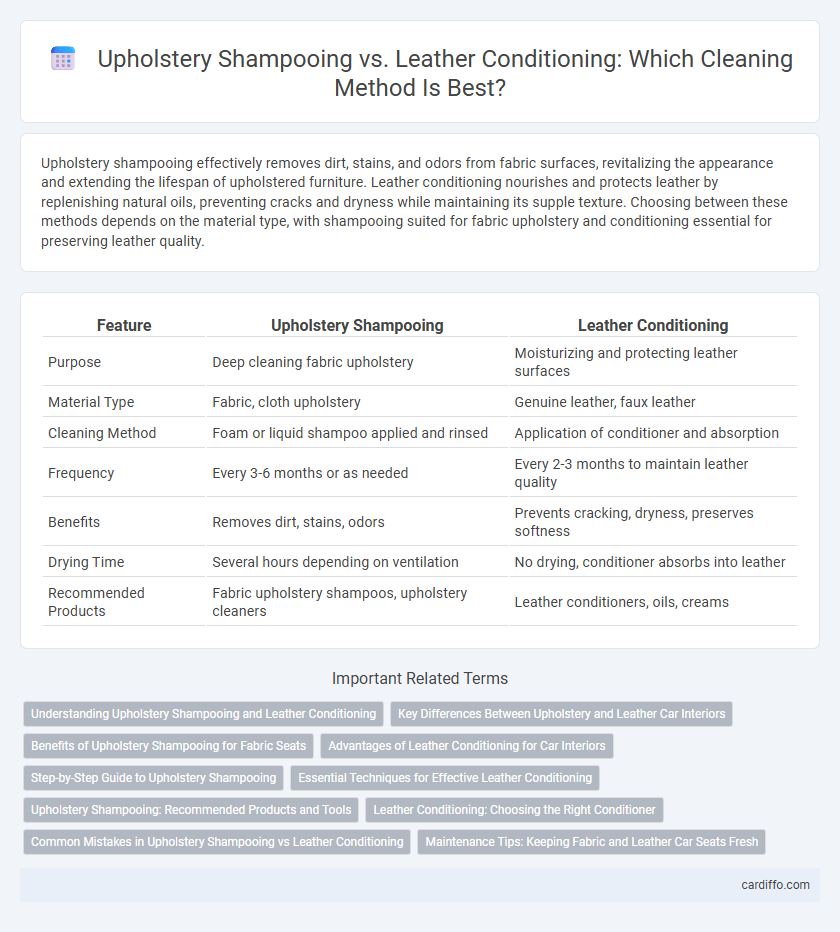Upholstery shampooing effectively removes dirt, stains, and odors from fabric surfaces, revitalizing the appearance and extending the lifespan of upholstered furniture. Leather conditioning nourishes and protects leather by replenishing natural oils, preventing cracks and dryness while maintaining its supple texture. Choosing between these methods depends on the material type, with shampooing suited for fabric upholstery and conditioning essential for preserving leather quality.
Table of Comparison
| Feature | Upholstery Shampooing | Leather Conditioning |
|---|---|---|
| Purpose | Deep cleaning fabric upholstery | Moisturizing and protecting leather surfaces |
| Material Type | Fabric, cloth upholstery | Genuine leather, faux leather |
| Cleaning Method | Foam or liquid shampoo applied and rinsed | Application of conditioner and absorption |
| Frequency | Every 3-6 months or as needed | Every 2-3 months to maintain leather quality |
| Benefits | Removes dirt, stains, odors | Prevents cracking, dryness, preserves softness |
| Drying Time | Several hours depending on ventilation | No drying, conditioner absorbs into leather |
| Recommended Products | Fabric upholstery shampoos, upholstery cleaners | Leather conditioners, oils, creams |
Understanding Upholstery Shampooing and Leather Conditioning
Upholstery shampooing involves deep cleaning fabric furniture by removing dirt, stains, and allergens using specialized shampoos that penetrate fibers. Leather conditioning, on the other hand, focuses on maintaining leather's suppleness and preventing cracking by applying moisturizing agents and protective lotions. Both processes enhance furniture longevity but target different materials and require specific products designed for fabric or leather care.
Key Differences Between Upholstery and Leather Car Interiors
Upholstery shampooing targets fabric car interiors by deep-cleaning fibers to remove dirt, stains, and odors, while leather conditioning nourishes and protects leather surfaces to prevent cracking and fading. Fabric materials require water-based cleaners and agitation, whereas leather demands specialized conditioners and minimal moisture to maintain suppleness. The distinct cleaning needs emphasize tailored products and techniques for effective maintenance of upholstery and leather car interiors.
Benefits of Upholstery Shampooing for Fabric Seats
Upholstery shampooing effectively removes embedded dirt, stains, and allergens from fabric seats, enhancing the cleanliness and appearance of the upholstery. This deep cleaning process helps maintain the fabric's texture and color, prolonging the lifespan of the seats. It also improves indoor air quality by eliminating dust mites and bacteria trapped in the fibers.
Advantages of Leather Conditioning for Car Interiors
Leather conditioning enhances car interiors by preserving the natural suppleness and preventing cracks, extending the lifespan of leather seats. It creates a protective barrier against spills, UV rays, and dirt, maintaining a pristine and luxurious appearance. Regular conditioning also restores faded leather, improving comfort and retaining the vehicle's resale value.
Step-by-Step Guide to Upholstery Shampooing
Start by vacuuming the upholstery thoroughly to remove loose dirt and debris. Mix the upholstery shampoo according to the manufacturer's instructions, then apply it evenly using a soft brush or sponge, working in small sections. Rinse the cleaned areas with a damp cloth to remove residue and allow the fabric to dry completely before use.
Essential Techniques for Effective Leather Conditioning
Leather conditioning requires thorough cleaning with a pH-balanced leather cleaner to remove dirt and oils before applying a conditioner to restore moisture and prevent cracking. Use a soft cloth or applicator pad to evenly spread the leather conditioner, allowing it to absorb fully for optimal softness and flexibility. Regular conditioning every 3 to 6 months enhances leather durability, maintaining its natural texture and extending the lifespan of upholstery.
Upholstery Shampooing: Recommended Products and Tools
Upholstery shampooing requires specialized products like foaming upholstery shampoo and fabric-specific detergents to effectively remove dirt and stains without damaging fibers. Essential tools include a soft-bristle brush for scrubbing, a handheld extractor or wet vacuum for deep cleaning, and microfiber cloths for drying and blotting excess moisture. Opting for pH-balanced shampoos and using a steam cleaner can enhance cleaning efficiency while preserving upholstery quality.
Leather Conditioning: Choosing the Right Conditioner
Leather conditioning extends the lifespan of genuine leather by replenishing natural oils and preventing drying or cracking. Selecting the right conditioner depends on leather type, intended use, and compatibility, with options ranging from natural oils like mink oil to synthetic blends offering UV protection. Regular application improves texture, enhances appearance, and maintains the leather's durability against wear and environmental exposure.
Common Mistakes in Upholstery Shampooing vs Leather Conditioning
Common mistakes in upholstery shampooing include using excessive water, which can lead to mold growth and fabric damage, and selecting inappropriate cleaning agents that cause discoloration or fiber weakening. In leather conditioning, frequent errors involve over-application of conditioner, resulting in buildup and a sticky surface, and neglecting to clean the leather thoroughly beforehand, which reduces conditioning effectiveness. Proper method knowledge is crucial to maintain upholstery integrity and extend the lifespan of leather furniture.
Maintenance Tips: Keeping Fabric and Leather Car Seats Fresh
Regular upholstery shampooing removes deep-seated dirt and stains from fabric car seats, preserving their appearance and preventing odor buildup. Leather conditioning maintains the natural oils in leather seats, preventing cracks and dryness while enhancing durability. Combining routine cleaning with proper protection ensures long-lasting freshness and comfort for both fabric and leather car interiors.
Upholstery Shampooing vs Leather Conditioning Infographic

 cardiffo.com
cardiffo.com